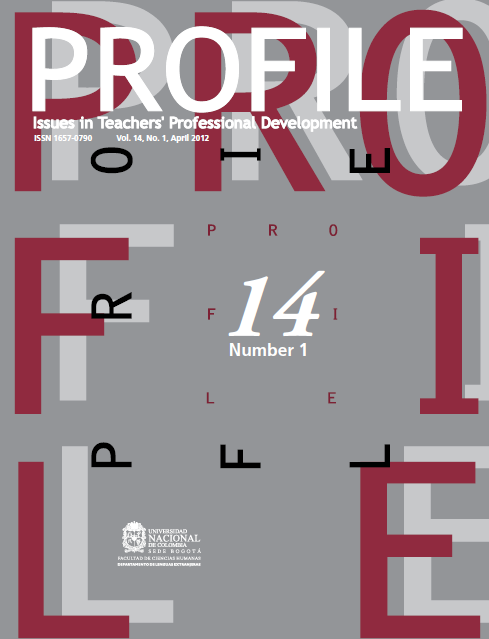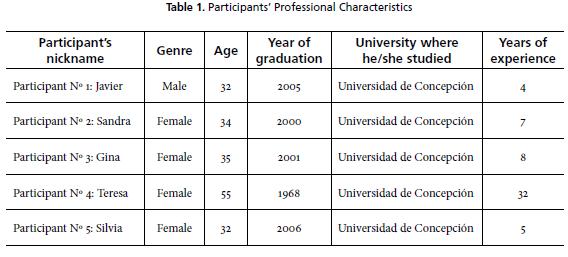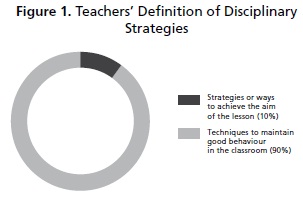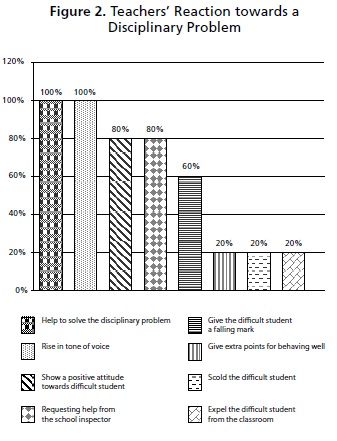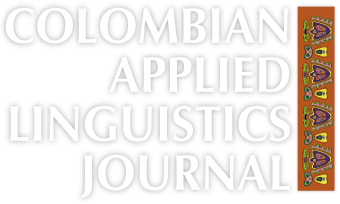Using Case Study Methodology to Approach the Views of Teachers of English on Classroom Disciplinary Strategies
Palabras clave:
Case study research in EFL, disciplinary strategies, English learning, foreign language learning. (en)Descargas
This qualitative study aims at identifying the disciplinary strategies claimed to be used by a group of five secondary classroom teachers of English in public or semi-public schools in Chile. To conduct this research, a semi-structured interview was applied to participants. The data were analyzed using the principles of semantic content analysis and the grounded theory technique in order to organize the categories and subcategories from the data. The results show that some of the teachers declare using a rising tone of voice, scolding and expelling difficult students from the classroom as key disciplinary techniques; other teachers claim that disciplinary strategies help them to accomplish the teaching aim in a lesson.
Este estudio cualitativo tiene como objetivo identificar las estrategias disciplinarias que declara usar un grupo de cinco profesores de inglés como lengua extranjera, de la enseñanza secundaria, que laboran en la educación pública o semipública en Chile. El estudio se basó en una entrevista semiestructurada, cuyos datos se interpretaron a partir de los principios del análisis del contenido semántico y la técnica de la teoría fundamentada. Luego se organizaron en categorías y subcategorías. Los resultados muestran que la mayoría de los informantes declara aumentar el tono de su voz o emplear la reprensión y la expulsión del aula como técnicas para mantener la disciplina. Otros expresan que las estrategias de disciplina les ayudan a alcanzar el objetivo de la clase.
Using Case Study Methodology to Approach the Views of Teachers
of English on Classroom Disciplinary Strategies*
Uso de la metodología de estudio de casos para aproximarse a las concepciones
de profesores de inglés sobre las estrategias disciplinarias en el aula
Claudio Díaz Larenas
Universidad de Concepción, Chile
claudiodiaz@udec.cl
This article was received on April 25, 2011, and accepted on December 17, 2011.
This qualitative study aims at identifying the disciplinary strategies claimed to be used by a group of five secondary classroom teachers of English in public or semi-public schools in Chile. To conduct this research, a semi-structured interview was applied to participants. The data were analyzed using the principles of semantic content analysis and the grounded theory technique in order to organize the categories and subcategories from the data. The results show that some of the teachers declare using a rising tone of voice, scolding and expelling difficult students from the classroom as key disciplinary techniques; other teachers claim that disciplinary strategies help them to accomplish the teaching aim in a lesson.
Key words: Case study research in EFL, disciplinary strategies, English learning, foreign language learning.
Este estudio cualitativo tiene como objetivo identificar las estrategias disciplinarias que declara usar un grupo de cinco profesores de inglés como lengua extranjera, de la enseñanza secundaria, que laboran en la educación pública o semipública en Chile. El estudio se basó en una entrevista semiestructurada, cuyos datos se interpretaron a partir de los principios del análisis del contenido semántico y la técnica de la teoría fundamentada. Luego se organizaron en categorías y subcategorías. Los resultados muestran que la mayoría de los informantes declara aumentar el tono de su voz o emplear la reprensión y la expulsión del aula como técnicas para mantener la disciplina. Otros expresan que las estrategias de disciplina les ayudan a alcanzar el objetivo de la clase.
Palabras clave: aprendizaje del inglés, aprendizaje de una lengua extranjera, estudio de casos en lengua extranjera, técnicas disciplinarias.
Introduction
The mere fact of teaching a foreign language can be a challenge for teachers around the world. But what can even be a more difficult task to accomplish is to maintain discipline in a classroom full of high school learners. A double task is needed: to make the English learning process efficient and successful and to create a pleasant and disciplined atmosphere that allows learning to take place. As a matter of fact, because of the particular nature of the field of teaching English as a foreign language, certain conditions and disciplinary behaviors are needed to accomplish learning tasks.
To master English has become a very highly valued skill in Chile, particularly when graduates have to find a job. English is taught in primary, secondary and even tertiary education; however, it's common to hear from primary and secondary teachers of English that disruptive behavior in the classroom is a strong barrier to teaching English. In this case study, five Chilean teachers of English of public and semi-public schools were interviewed to explore the phenomenon of disciplinary strategies in the EFL classroom.
This paper is organized into five main sections: theoretical background, research design, data analysis and discussion, conclusions and pedagogical implications and references. The section below outlines the key literature we consulted to approach the issue of disciplinary strategies.
Theoretical Background
The concept of disciplinary strategies has been widely defined by several authors worldwide (Brown, 2010; Cubero, 2004; Charles, 1999; Gootman, 2008). Socolinsky (1994), for example, defines discipline as a "set of rules established for an individual or group of people, intended to maintain order, classroom interaction and the sound development of group activities" (p. 24). Discipline is not just a phenomenon that occurs at school but also at home, at work, or in every aspect of people's lives. For Ramo and Cruz (1997), discipline in educational centers implies a set of strategies used by teachers and provides a model of behavior to achieve learning and co-existence among students. Discipline is a crucial factor in every society as it is the starting point to achieve its goals, as such.
De Almeida (2007), in her study entitled Discipline problems in the EFL class: Is there a cure? states that discipline is a key issue for learning and teaching to be effective. In her action-research project she claims that "above all, we should value students as individuals and show them they are capable of going beyond their perceived limitations. We should also help them to understand that they are responsible for building up the learning atmosphere by contributing their share to the learning process" (p. 12). Lorduy (2008) in her study Pre-service English teachers' beliefs about discipline at Universidad de Cordoba declares that "beliefs about discipline are important predictors of classroom actions. Self-efficacy beliefs are determinant in the way teachers approach their capacity to organize and execute action in the class" (p. 136). Sali (2011) in her study An inquiry into EFL teachers' and learners' perspectives on classroom discipline concludes that for Turkish EFL teachers and learners, the teacher is the one and only mighty figure in the classroom.
Lewis, Romo, Qui and Katz (2005) also report that teachers' disciplinary strategies are related to a number of factors, including students' ages and sex. Their paper on Teachers' classroom discipline in Australia, China and Israel claims that "lack of discipline ranks within the first two most serious problems confronting the public schools today" (p. 1).
Discipline becomes a problem when it does not exist. Ur (1996), for example, points out that "although the immediate responsibility for the maintenance of classroom discipline in most situ-ations is the teacher's, the ultimate goal is to reach the point where learners take on or at least share this responsibility" (p. 264). When misbehavior arises in class or even before it appears, it is good for teachers to know what to do or how to manage the conflicting situation. Teachers can certainly use a variety of disciplinary strategies to manage disruptive behavior in the classroom, and the best way to control it is to prevent it from happening.
Brown (2010) suggests that there is a necessity for teachers to be well-prepared in terms of disciplinary strategies to prevent the use of punishment because the application of it often has negative effects on behavior modification. McDaniel (1986) and Herr, Reid and Herr (1996) converge on the idea that experienced educators use disciplinary strategies in order to help with the difficult work that teaching is. Another problem related to discipline that may emerge in the classroom is the misuse or poor selection of disciplinary strategies. Through disciplinary strategies, the process of teaching turns out to be easier to guide because educators have the responsibility of teaching not only the academic aspects established in the curriculum, but also teaching discipline, respect for others, and respect for the school rules.
Successfully disciplined classrooms would possibly be, according to Ur (1996), those where learning takes place, that is to say, a place where the learning process is achieved successfully. As already known, this process involves the active participation of both teachers and students. It requires interaction between them, so that the learner is able to finally learn successfully.
In order to identify a disciplined classroom, Moss (2010), Oliver and Reschly (2010) and Ur (1996) suggest some of the following factors that could contribute to it: teachers' competences in classroom management, the methodologies applied, the interpersonal relationships among students and the teacher himself, the lesson planning, and of course the learner's motivation as regards the lesson. Moreover, they recommend some tips to use in the classroom when indiscipline has not yet emerged, when it is just emerging, and finally, when it has emerged. Some of these tips involve keeping in touch with the students at every moment in the classroom, dealing with discipline very quietly and calling their attention individually; in other words, never take problems personally. This means not to let the student pull the teacher into personal conflict.
The American Board for Certification of Teacher Excellence (2007) defines disciplinary strategies as all the tools used by a teacher to obtain and maintain discipline in the classroom. Such tools may be "employing the evil eye, asking the students to stop misbehaving (...) moving to or stand in close proximity to the troublesome student (...) tell the students to remain, once class is over (...) call parents (...) moving the student's seat, assigning non-physical punishment, among others" (p. 105).
Classroom management strategies are significant in terms of organization and order for teachers and learners to achieve a sense of discipline. Maintaining order and discipline within the classroom is a difficult task to accomplish if the teacher does not have a good repertoire of rules that could help her/him prevent misbehavior rather than find ways to punish it (Oliver & Reschly, 2010). Disciplinary strategies help teachers to organize themselves in the classroom environment, to develop awareness of their teaching process, and to deal with learners' misbehavior and confront disciplinary situations (Camenson, 2007; McDaniel, 1986; Rose, 2006; Sicurelli, 2010).
High School Learners and Discipline
A learner is any individual who is undergoing a schooling process. This means that a learner could be a young child, as well as an adolescent or an adult. Muzzo and Burrows (1986) state that, based on experts of the World Health Organization, the approximate age that delimits adolescence from childhood and adulthood falls between 10 and 20 years old. Muzzo and Burrows (1986) and Williams and Burden (1997) also explain that adolescence is a period of every individual's development where several changes take place. The individual starts reaching a process of biological maturity which involves psychological and social issues and the beginning of an identification of the personality process. All of these significant changes make a major adjustment in the mental structure of students, a fact that can influence their learning process.
Harmer (2001) and Montijano (2001) claim that teaching to diverse age groups is considerably different. This is mainly because of the different psychological characteristics particular to every age group and their level of mental development. According to this position then, teaching adolescents would be one of the greatest challenges as they are going through a radical change in terms of physical and mental structures. Adolescence is a period in which teenagers start defining their personality and identity, as well as their capacity of abstraction and adaptation to the social environment that surrounds them. The changes students go through may affect their learning process together with their behavior in classes. Harmer (2001, p. 11) also adds that "one of the recurring nightmares for teachers of adolescents is losing control". This loss of control could be due to the students' dislike of the subject, the teacher, their classmates or just because they do not feel like participating. All of these are a consequence of the well-known changes that affect an adolescent. It is of high importance then that teachers should be very aware of these psychological changes in order to be careful when dealing with adolescents and their particular needs in a classroom.
Research Question and General Objective
Since this research aimed at understanding teachers' views on disciplinary strategies, the following question was set:
• What kind of disciplinary strategies does a group of five secondary teachers of English declare to use to control discipline in the EFL classroom at four Chilean secondary schools?
Research Design
This section describes the type of study that was conducted based on the qualitative paradigm which, according to Creswell (2003, p. 4), "is a means for exploring and understanding the meaning individuals or groups ascribe to a social or human problem"; that is to say, it is used to understand different people's beliefs, perceptions, feelings, ways of thinking, among others. Within the qualitative paradigm, this research is an interpretative case study that provides a rich and profound description of the data given by the five participants (Nunan & Bailey, 2009; Rodrigues, 2010; Sealey, 2010).
Participants
In order to fulfil the research objective, a group of five secondary teachers of English, whose native language is Spanish, were interviewed to find out the main disciplinary strategies they declare they use to control their EFL classes. These participants come from either the public or semi-public educational systems. The public sector schools refer to educational establishments that are completely owned and subsidised by the state and the semipublic schools involve institutions that are privately owned, but receive a subsidy from the state based on students' class attendance. Both public and semi-public schools hold large classes, which are very likely to present disciplinary issues.
The researchers who conducted this study consisted of a group of five practitioners led by a senior university professor who had done qualitative research before and was familiar with content analysis, subjectivity, triangulation and data reliability.
Five participants provided the data to conduct this study. The first participant was a 32-year-old male teacher who had 4 years of professional experience in the EFL field and worked in a semi-public school. The second participant was a 34-year old female who had 7 years of experience in the English teaching field and worked in a public school.
The third participant was a 35-year-old woman who had been working as a teacher of English for 8 years in the same public school. Participant four was a 55-year-old female teacher who had been working in the public system for over 32 years. Finally, the fifth participant was a 32-year-old female teacher who had graduated from university four years earlier and was currently working in a public school.
All of the participants graduated from the same university in Concepción, Chile. Table 1 presents a more detailed summary of the participants and their most relevant characteristics in the context of this research.
The participants in this research were also collaborating teachers who supervised teacher candidates who were doing their practicum or internship in different high schools.
Instrument
This research uses a semi-structured interview to examine the participants' views. According to Olabuénaga (2003) and Sealey (2010), an interview is a qualitative type of instrument based on a reflective and verbal data collection, and where an interviewer and an interviewee interact. A semi-structured interview gives us the possibility to follow topical trajectories in the conversation that may stray from the guide when necessary (Pérez, 1998).
This instrument is a seventeen open-ended question interview designed to identify the most common disciplinary strategies claimed to be used by teachers to control classroom discipline. These are some of the questions used in the protocol:
- What is your own understanding of disciplinary strategies?
- How do you react when misbehavior arises in your classroom?
- What are your reasons for using disciplinary strategies when dealing with misbehavior?
The instrument was externally validated by a group of five university teachers who read and analyzed the interview to see if it matched the research question and objective. The five reviewers gave feedback and suggestions on the instrument to finally create a semi-structured interview capable of collecting reliable and meaningful data.
Procedure
After having defined the participants' selection criteria, the interviewer visited the schools to start the data collection. They were selected on the basis of their time availability and willingness to take part in the research. Once in the school, they were isolated in a private room where they were explained what the interview was like and the procedure they would follow. The interviewer would also clarify any questions, if necessary, while applying the instrument. Then the interviews were conducted in English with occasional interruptions due to clarification matters. The process of applying each semi-structured interview to the participants took roughly 25 to 30 minutes per person.
A semantic content analysis and a Grounded Theory screening of all the responses were conducted to identify categories and subcategories to describe the content (Trinidad, Carrero, & Soriano, 2006). Content analysis investigates the thematic content of text and serves as a basis of inference (Dean-Brown & Rodgers, 2002; Herzog, 1996; Merriam 1998; Sabino, 1996). Initially, manual coding of each response was conducted to identify words, phrases, or word-phrase clusters for the purpose of this analysis. Preliminary categories were modified and refined jointly by the researchers based on the data. The steps used during data analysis for this study (Creswell, 2003; Pérez, 1998; Ruiz, 1996; Sandín, 2003; Sealey, 2010; Stake, 1999) are described next.
- Level 1 (data segmentation). To bring meaning, structure, and order to these data, the entire data set was first segmented based on the research question and the nature of the data.
- Level 2 (initial coding). Codes were identified based on the results of the initial open coding. These initial categories were generated from participants' original responses and discrepancies in labels were resolved through negotiation between the researchers. A constant comparison approach was used during the initial coding.
- Level 3 (categorizing). To identify the relationship among the initial codes, the researchers compared the coding labels to the related literature.
- Level 4 (exploring relationships). In this study, each response was linked to each dimension.
Data Triangulation
To validate the findings, researcher triangulation was used to make the final results more reliable (Rodrigues, 2010). The process of triangulation took several and constant revisions in order to end with meaningful and accurate information for this research. The data were constantly reduced, coded, described, interpreted, compared and saturated.
Data Analysis and Discussion
Table 2 shows the dimension of disciplinary strategies.
Category 1: Definition of Disciplinary Strategy
The first category to be analyzed is the definition of disciplinary strategy where two different conceptions came from the teachers. On the one hand, disciplinary strategies are regarded as techniques to maintain good behavior in the classroom and, on the other, they are viewed as ways to achieve the lesson aim. The participants below stated the following about disciplinary strategies when they were interviewed.
Sandra: For me disciplinary strategies are techniques teachers can use to conduct a class in an orderly way.
Teresa: Disciplinary strategies are different ways one turns to when you have to control the class to achieve the lesson aim and cover the contents.
It can be said that the concept of disciplinary strategies is understood similarly by the teachers of both public and semi-public schools. This could be due to the fact that all of the participants did their undergraduate training at the same university; therefore, they shared a common curriculum that engaged them in similar academic tasks and experiences, which may be influencing their similar views on disciplinary strategies. Besides, public and semi-public schools provide strikingly similar work environments that are characterized by large classes, sporadic teacher training and lack of time for teachers to engage in professional development.
The participants' responses match what the literature review states about considering disciplinary strategies as a set of rules intended to maintain order and the development of group activities (Socolinsky, 1994); however, their responses do not seem to reveal any reference to other educational objectives such as how disciplinary strategies could eventually help to foster classroom interaction, interpersonal relationships and learner motivation as Moss (2010), for example, points out in the theoretical background section.
It can also be thought that these participants have gone a step further when they mention that the implementation of effective disciplinary strategies allows teachers to accomplish their teaching aim in a lesson because they do not just adhere to the obvious definition that disciplinary strategies only help to maintain order and control in the classroom. Figure 1 represents the different definitions provided by the participants.
Category 2: Teachers' Reaction Towards a Disciplinary Problem
The second category to be analyzed is teachers' reactions towards a disciplinary problem. Within this category, the participants provided 13 different associated subcategories. The majority of the participants agree that when running into a disciplinary problem, they try to solve the conflict usually by raising their tone of voice or by showing a positive attitude towards the difficult students. As has been stated by McDaniel (1986) and Moss (2010), teachers may use different tools to control disciplinary issues such as intimidating eye contact, a demand for students to quit misbehaving or a change in seating arrangement.
Needless to say, it might not be necessary to use all of these disciplinary strategies at once, but rather consider the nature of the disciplinary problem to decide on the strategy to be used. If it is an issue that might require more help to be solved than usual, it is possible to use a wide variety of disciplinary strategies, but if the issue has a more complex nature, teachers would often request the school inspector's help.
Teachers' reactions such as giving the difficult students a failing mark, giving them extra points for behaving well, reprimanding them severely for being rude and expelling them from the classroom when they behave badly are considered, by the participants, as negative reactions on the part of the teacher. The quote below, from one of the participants, illustrates this point.
Silvia: I do not like to reprimand or expel my students from the classroom. That is not good. I do not give them low marks for misbehavior either... those are negative actions.
Nonetheless teachers claimed not to like using punitive methods and consider those negative. Some of them listed them among their strategies. Many of these teachers' reactions are associated with a behaviorist teaching model that aims at producing control, authority and obedience rather than asking learners to be accountable for their personal actions. The reactions Silvia mentions might occur due to the teachers' lack of teaching experience to control the class, old-fashioned thoughts on discipline that associate marks with good behavior or lack of patience on the part of the teacher. It is worth clarifying at this point of the discussion that teachers' reactions toward an act of indiscipline is contextually and culturally bound, that is to say, societies build their own codes of discipline and strategies to approach it; therefore, what may be a right way or procedure to deal with rowdy behavior in one country may not be in another.
Teachers' positive reactions towards an act of indiscipline are based on the importance of conversing with students to solve a conflict. Because of this, teachers must always show a calm attitude towards situations that have gotten out of control, paying special attention to the physiological and physical characteristics of the learner they teach. Javier, one of the participants, states the following:
Javier: To talk, to have a conversation with unruling students... this helps a lot to solve a problem...I believe teachers must be calm when dealing with misbehavior.
As stated by Muzzo and Burrows (1986), adolescence is a period of every individual's development where several changes take place. Since each student is a unique individual, he/she goes through a series of different physiological changes that affect him/her not only at school, but also in every aspect of his/her life. Having a positive attitude towards difficult students may benefit the creation of a smooth atmosphere between teachers and their students, facilitating discipline in the classroom. The following quotes extracted from the interviews illustrate the ideas expressed in this paragraph.
Sandra: I like to build a pleasant atmosphere when I teach. I don't like to treat difficult students badly.
Gina: Classroom atmospheres are crucial to have good discipline in the classroom.
Interestingly enough, participants seem to share the same ideas about the concept of disciplinary strategies. This concept has to do with getting students aware of the fact that their disruptive behavior is affecting the flow of the lesson and that they want that behavior not to appear again. Participants, for instance, give difficult students a written warning in their personal record or confiscate a student's personal item. For several researchers and authors (Charles, 1999; Gootman, 2008; McDaniel, 1986), those strategies are not always effective since they imply that the teacher has the ultimate power in the classroom and that the learner is a passive recipient.
Besides, according to the participants' responses, raising their tone of voice is the most used strategy to maintain discipline. If this strategy does not work, they use another type of strategy that is, generally, talking directly to the students or calling on their parents for an interview. The following fragments give more insight on this issue.
Javier: To draw their attention, I interrupt them, call them by their names and ask them to stop doing what they are doing.
Silvia: I usually tell them that they are interrupting the lesson.
In Figure 2, teachers' reactions towards a disciplinary problem are represented to show the frequency of different strategies teachers use to face a disciplinary issue in the classroom.
Category 3: Effectiveness of Teachers' Disciplinary Strategies
For Sali (2011), disciplinary strategies turn out to be ineffective if teachers assume that they are the only ones who can set the classroom rules. This view is incompatible with the premises of learner-centered teaching. One of these premises recommends that teachers should create opportunities for the negotiation of learning and teaching perspectives on classroom happenings. One of the participants in this study accords strongly with the issue of negotiation between teachers and students, as the quote below states:
Gina: At the beginning of each year I usually negotiate classroom rules. I like students to see they have something to say about discipline.
Most of the time teachers who participated in this study consider the application of certain disciplinary strategies to control the class as effective; however, they also admit that an array of different strategies is usually needed to maintain discipline because every student reacts differently to the strategy applied. For some disruptive learners, certain strategies are more effective than others. Moreover, for some teachers, the uncertainty of what strategies to use to face a disciplinary issue may have its origin in their lack of self-confidence when dealing with discipline (Brown, 2010; Herr et al., 1996). The extracts below show teachers' opinions about the effectiveness of disciplinary strategies.
Sandra: Disciplinary strategies sometimes work, sometimes don't. It really depends on the group of students. Some students change their attitude, others don't.
Figure 3 shows participants' perception of disciplinary strategies effectiveness.
Category 4: Reasons for Students' Misbehavior and Teachers' Disciplinary Actions
Indiscipline is certainly present in all different educational realities -public, semi-public and private- and teachers must deal with it every single day in their schools. It is no surprise then that participants have five important reasons to explain students' misbehavior, leading them to disciplinary actions.
Figure 4 illustrates the reasons participants give for students' misbehavior in the English lesson:
(1) some of their students respect neither each other nor the teacher. This situation may be generated as a consequence of the increasing presence of bullying among learners, students' immaturity level, and social issues that learners start experiencing at home and, subsequently, at school. (2) The increasing presence of hyperactive students who require a great deal of attention on the part of the teacher. These students show rather impulsive behaviors since they let their feelings take control over their actions inside and outside the classroom and it is difficult for them to stay focused on the class and on the teacher, generating conflicting situations. (3) Students' lack of guidance at home. These three reasons might lead teachers to feel forced to use disciplinary strategies so that they can create a productive working environment. The following quotes illustrate the three points just explained.
Teresa: Disciplinary strategies are a must in the classroom. Some students are very immature, they have social issues, they do not respect anybody, they are constantly bullying others.
Javier: I need to use disciplinary strategies, because my students come from homes in which there is no discipline.
Sandra: Every year we happen to have more hyperactive students...I don't know what is happening, but it is hard for me to control those students.
A fourth reason that teachers mention has to do with long daily schedules for students, which in relation to what teachers state, depends very much on the type of school they attend: public or semipublic. Semi-public schools have more class hours because students must enroll in extracurricular activities for the benefit of their personal development. Students may often misbehave due to the timetable in which English is taught during their daily schedule, that is, very early in the morning or late in the afternoon when they are generally sleepy or tired. The issue of long school schedules is reported by the following participant.
Silvia: To keep a student from 8 am to 5 pm at school is exhausting and this is clearly a cause for misbehavior.
The fifth reason teachers report to explain students' rowdy behavior in the English lesson is the status of the subject in the whole curriculum. English is unfortunately viewed as a less important subject than others like maths or Spanish (Díaz, Martínez, Roa & Sanhueza, 2010). This is partly explained by the fact that Chile is a Spanishspeaking country very much isolated from English speaking environments. This issue is pointed out by the following participant:
Silvia: English is not important for the students. All the other subjects are far more important for them.
Conclusions and Pedagogical Implications
Discipline is not only useful, but also an essential issue inside the classrooms because there is a close relationship between discipline and the way it affects learning: the former plays an important role in the classroom environment, which is clearly one relevant factor in the English teaching and learning process. When teaching a foreign language, teachers often have to face and deal with the most unimaginable and different sorts of difficulties that might arise in the classroom and without doubt these situations may affect the learning process.
Teachers have an essential role when facing discipline and it is an important task for them to look for the most suitable and appropriate tools or strategies. It is also crucial to apply these strategies in the right time and place, thus the correct use of disciplinary strategies could enable teachers to control the class and overcome misbehavior on the students' part. As a result of this, teachers and students can take advantage as much as possible of the available time in class and, therefore, attempt to succeed in the challenge of learning a foreign language.
The participants' conceptualization of disciplinary strategies stresses both the role that these strategies play in maintaining discipline in the classroom and in accomplishing the lesson objective. This leads one to think that disciplinary strategies should be an essential component of teacher preparation programs. These programs should focus on three key components to empower future teachers to deal with classroom discipline effectively: (1) classroom management skills, (2) field experiences for future teachers to try out those skills and (3) opportunities for reflections on classroom misbehavior issues.
The participants of this study show an array of disciplinary strategies that they employ when they have to deal with indiscipline in the classroom or rowdy students; however, it is observed that most of these strategies are teacher-centered and more inclined toward a behaviorist model of teaching that does not give space to students' contribution to the learning process. The understanding that students are also responsible for building up the learning atmosphere is central to getting disciplinary strategies to work in the classroom. The establishment of disciplinary strategies should be a collective and democratic exercise between teachers and students. This way, students become more aware of their share and responsibility for keeping a good working atmosphere. In the end, what matters is to break the idea that the teacher is the one and only mighty figure in the classroom as Sali (2011) pointed out in the theoretical background.
Ur (1996, p. 264) mentions that "although the immediate responsibility for the maintenance of classroom discipline in most situations is the teacher's, the ultimate goal is to reach the point where learners take on or at least share this responsibility". Students really need to develop autonomy and self-awareness as regards how they behave in the classroom, to think about their behavior as well as the reasons that cause indiscipline. This is certainly a task that both teachers and students have to work on so that the objective of the class as well as discipline maintenance can be achieved.
Besides, the students' inability to see the importance of learning a foreign language may be influenced by teacher-centered lessons in which teachers do not focus on students' language needs, but only on giving their lecture during the whole class time without noticing students' lack of motivation; therefore, students start misbehaving during the English lesson.
It is also of great importance for teachers to monitor how effective the disciplinary strategies they utilize are because the use of actions to control discipline on the part of the teacher should not be understood as punitive and negative behaviors by the students. Teachers' use of disciplinary strategies should not affect teacher-student rapport or create an unfriendly, threatening classroom atmosphere. The use of action research appears as a possible tool for teachers to explore and research the difficulties that indiscipline poses in each classroom and the causes for students to misbehave. After all, each classroom is a unique world; therefore, there is not a single answer for approaching indiscipline, its causes and consequences.
When it comes to the reasons that the participants give for using disciplinary strategies, they refer to a worldwide issue that has to do with students' understanding of what respecting each other means. Misbehavior very often arises because of students' disrespect toward others. The interesting thing to find out in future research is what pushes students not to respect others and why the number of hyperactive students is increasing every day in schools. Bullying turns out to be another important issue that is at the heart of discussion today and is worth researching. Teachers and students should look into bullying critically so as to make everybody in this society more aware of how crucial tolerance, respect and communication are to avoid bullying.
Finally, Grossman (2004), in an attempt to help teachers deal with unruly students, suggests that teachers should stress internal, not external control and intrinsic, not extrinsic motivation because when these students exercise their self-control, they improve their relationships with others. Moreover, the use of certain motivational techniques helps students become more able to account for their own actions and accept the impact their actions may play in evoking responses from others.
*This paper is part of the thesis entitled "The use of disciplinary strategies and the effects of punishment in the EFL classroom: teachers of English' and students' views", and the research grant FONDECYT 1085313 entitled "El Sistema de Cognición Docente, las Actuaciones Pedagógicas del Profesor de Inglés Universitario y su Impacto en la Enseñanza-Aprendizaje del Idioma". Acknowledgements to the following practitioners for their hard work in this research: Camila Cordova Cañete, Jael Flores Flores, Natalia Perales Cruces, Carol Puentes Sánchez and María Isabel Torres Faundez.
References
American Board for Certification of Teacher Excellence (2007). Classroom management: techniques for addressing student discipline problems part II. Retrieved from http://www.abcte.org/files/previews/preptoteach/s5_p1.html
Brown, A. (2010). Classroom management: Punishment versus discipline. Retrieved from http://www.ehow.com/facts_5875823_classroom-management_-punishment-vs_-discipline.html
Camenson, B. (2007). Opportunities in teaching English to speakers of other languages. New York, NY: McGraw Hill Press.
Charles, C. (1999). Building classroom discipline. New York, NY: Longman Press.
Creswell, J. (2003). Research design. Qualitative, quantitative and mixed methods and approaches. London: SAGE Publications.
Cubero, C. (2004). La disciplina en el aula: reflexiones en torno a los procesos de comunicación. Revista electrónica Actualidades Investigativas en Educación, 4(2), 2-40. Retrieved from http://redalyc.uaemex.mx/pdf/447/44740202.pdf
De Almeida, D. (2007). Discipline problems in the EFL class: Is there a cure? PROFILE Issues in Teachers' Professional Development, 8, 1-13.
Dean-Brown, J., & Rodgers, T. (2002). Doing second language research. Oxford: Oxford University Press.
Díaz, C., Martínez, P., Roa, I., & Sanhueza, M. (2010). Una fotografía de las cogniciones de un grupo de docentes de inglés de secundaria acerca de la enseñanza y aprendizaje del idioma en establecimientos educacionales públicos de Chile. Revista Folios, 31(1), 69-80.
Gootman, M. (2008). The caring teacher's guide to discipline: Helping students learn self-control, responsibility and respect. California: Corwin Press.
Grossman, H. (2004). Classroom behavior management for diverse and inclusive schools. Maryland: Rowman and Littlefield Publishing Group.
Harmer, J. (2001). The practice of English language teaching. London: Longman.
Herr, D., Reid, L., & Herr, S. (1996, April). Training teachers for troubled times. Paper presented at the Annual Convention of the Council for Exceptional Children (74th), Orlando, FL. Retrieved from http://www.eric.ed.gov/PDFS/ED395406.pdf
Herzog, T. (1996). Research methods in the social sciences. New York, NY: Harper Collins.
Lewis, R., Romo, S., Qui, X., & Katz, Y. (2005). Teachers' classroom discipline in Australia, China and Israel. Revista Teaching and Teacher Education, 21(1), 729-741.
Lorduy, D. (2008). Pre-service English teachers' beliefs about discipline at Universidad de Cordoba. (Unpublished master's thesis). Fundación Universidad del Norte, Bogotá.
McDaniel, T. (1986). A primer on classroom discipline: Principles old and new. Boston: Phi Delta Kappan Press.
Merriam, S. (1998). Qualitative research and case study applications in education. San Francisco: Jossey-Bass Publishers.
Montijano, M. (2001). Claves didácticas para la enseñanza de la lengua extranjera. Málaga: Aljibe.
Moss, L. (2010). Classroom management & punishment. Retrieved from http://www.ehow.com/facts_7628849_classroom-management-punishments.html
Muzzo, S., & Burrows, R. (1986). El adolescente chileno: características, problemas y soluciones. Santiago: Editorial Universitaria.
Nunan, D., & Bailey, K. (2009). Exploring second language classroom research. A comprehensive guide. Boston: Heinle.
Olabuénaga, J. (2003). Metodología de la investigación cualitativa. Madrid: Universidad de Deusto Press.
Oliver, R., & Reschly, D. (2010). Improving students' out-comes in general and special education: Effective classroom management. Washington DC: Learning point associate, national comprehensive center for teacher quality.
Pérez, G. (1998). Investigación cualitativa: retos e interrogantes II. Madrid: La muralla S.A. Press.
Ramo, Z., & Cruz, J. (1997). La convivencia y la disciplina en los centros educativos. Madrid: Escuela Española Press.
Rodrigues, S. (2010). Using analytical frameworks for classroom research. London: Routledge.
Rose, M. (2006). The experience of language teaching. Cambridge: Cambridge University Press.
Ruiz, J. (1996). Metodología de la investigación cualitativa. Bilbao: Universidad de Deusto.
Sabino, C. (1996). El proceso de la investigación. Buenos Aires: Lumen Humanitas.
Sali, P. (2011). An inquiry into EFL teachers' and learners' perspectives on classroom discipline. Revista Iconte, 27(1), 673-680.
Sandín, M. P. (2003). Investigación cualitativa en educación. Fundamentos y tradiciones. Madrid: McGraw Hill.
Sealey, A. (2010). Researching English language. London: Routledge.
Sicurelli, M. (2010). Praise or punishments: Applying behaviorism in the classroom. Retrieved from http://joctl.blogspot.com/2010/11/praise-or-punishmentapplying.html
Socolinsky, N. (1994). La disciplina en el aula: ¿un callejón sin salida? Buenos Aires: Aique Press.
Stake, R. (1999). Investigación con estudio de casos. Madrid: Morata.
Trinidad, A., Carrero, B., & Soriano, R. (2006). Teoría fundamentada "Grounded theory". La construcción de la teoría a través del análisis. España: Centro de investigaciones sociológicas CIS Press.
Ur, P. (1996). A course in language teaching. Cambridge: Cambridge University Press.
Williams, M. & Burden, R. (1997). Psychology for language teachers. Cambridge: Cambridge University Press.
About the Author
Claudio Díaz Larenas, PhD in Education and Master of Arts in Linguistics. He teaches English Language, Discourse Analysis and EFL Methodology and Assessment at Universidad de Concepción, Chile. He works in the Facultad de Educación and Dirección de Docencia de la Universidad de Concepción. He has also researched in the field of teacher cognition and language assessment.
Cómo citar
APA
ACM
ACS
ABNT
Chicago
Harvard
IEEE
MLA
Turabian
Vancouver
Descargar cita
Visitas a la página del resumen del artículo
Descargas
Licencia
Los contenidos de la revista Profile: Issues in Teachers' Professional Development son de acceso abierto y los cubre la Licencia Creative Commons Atribución-NoComercial-SinDerivar 4.0 Internacional. Se autoriza copiar, redistribuir el material en cualquier medio o formato, siempre y cuando se conceda el crédito a los autores de los textos y a la revista Profile: Issues in Teachers' Professional Development como fuente de primera publicación. No se permite el uso comercial de copia o distribución de contenidos, así como tampoco la adaptación, derivación o transformación alguna de estos sin la autorización previa de los autores y de la Editora de la revista Profile: Issues in Teachers' Professional Development.
Los autores conservan la propiedad intelectual de sus manuscritos con la siguiente restricción: el derecho de primera publicación es otorgado a la revista Profile: Issues in Teachers' Professional Development.



